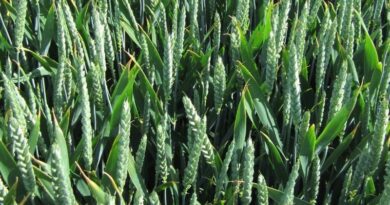Early phosphate ‘critical’ to help winter wheat crops recover
19 March 2024, UK: Phosphate fertiliser replacers have become an important part of early-season wheat agronomy on the heavy clay loam soils at Sykemouth Farm, Swineshead, Lincolnshire.
Whilst much cheaper than applying traditional fertilisers, the main reason for using these products is to get phosphate into plants quickly and efficiently to drive root growth and optimise tiller development and retention.
This puts plants into good shape ahead of stem extension and gives them the best possible chance of expressing their full potential at harvest.
Agrovista agronomist Phil Warham says: “That’s important in any season, but is critical in one like this when many wheat crops are struggling from the effects of tricky establishment and the soaking autumn and winter.”
Calfite Extra is a foliar nutrient complex that contains calcium phosphite, designed to improve crop rooting and to maximise nutrient uptake and utilisation. The product also contains L-PGA (pidolic acid) to increase nitrogen assimilation within the plant.
Luxor is a foliar-applied nutrient-biostimulant that boosts phosphorus availability. As well as foliar phosphorus, it contains humic and fulvic acids, which stimulate soil biology to maximise nutrient availability, and L-PGA.
“We’re using Calfite Extra and Luxor to no detriment to the crop and we have grain analysis from other farms to show how well it’s working,” says Phil.
“If plants don’t put down roots early in the spring they are going to really struggle for the rest of the season, whatever you try to do.”
All the wheats Phil looks after in his East Midlands area, including those at Sykemouth Farm, will have a Calfite Extra/Luxor treatment in the run up to T0.
“The indices here are very positive and we’re replacing P and K that we traditionally would have applied via bagged fertiliser after removing straw,” says Phil.
Ed Dowler, who manages 1200ha of cropping at Sykemouth Farm, including cereals, vining peas and sugar beet, has been using the products for the past two years.
“We grow wheat for feed and aim to average 10t/ha,” he says. “However, last autumn’s wet weather slowed up our drilling programme. Although we eventually managed to sow about 80% of the planned area, we have some very variable crops – a real mix of good and bad.
“We’ve used Calfite Extra in the autumn and Luxor in the spring for a couple of seasons. Crops have certainly looked very healthy after using them and we consistently hit our target yield.”
But, at the time of writing in mid-March, neither sprayer nor spreader had ventured out as rain topped up already sodden fields.
“We need to get our current crops moving quickly,” says Ed. “Once conditions are right Phil has recommended applying both products, before or soon after our early dose of nitrogen.
“Phil tells me a Calfite Extra/Luxor combination used at this time can turn an average crop into a better-than-average crop, and having seen what they can do I have no reason to doubt that.
“We’ve already invested a lot in our wheats, so we don’t want to compromise that.”
Phil advises applying Calfite Extra and Luxor at around T0. “A real plus point is that both are easy to use, they are well formulated, come out of the can easily and can be tank-mixed with anything, saving a pass at what can be a very busy time. I’ll typically recommend them with a growth regulator and fungicide.
“Products like these are manufactured to the highest degree and do what it says on the tin. They’ve put an end to the muck and mystery image and are now considered by many growers to be an essential part of their agronomy programmes that deliver a great return on investment.”
Also Read: Protecting Basmati Rice: Punjab Bans 10 Insecticides with High Residue Levels
(For Latest Agriculture News & Updates, follow Krishak Jagat on Google News)















